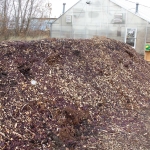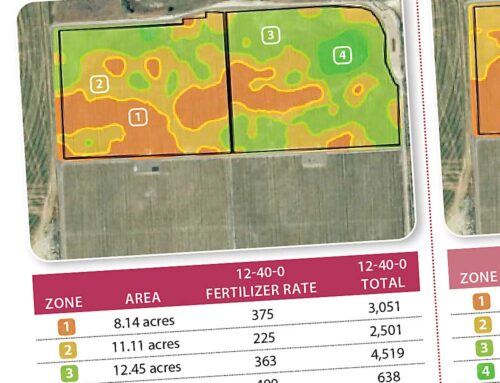One way to deal with winemaking leftovers is to turn it into compost. But as Washington State’s Walla Walla Community College has found, transforming grape pomace into compost required trial and error before perfecting the composting technique.
After every crush, wineries are left with the skins, pulp, seeds, stems, leaves, and other residue from winemaking after the juice has been pressed and fermented.
Uses for pomace include turning it into grape-based wine or distilled products, using it for cattle feed, recycling in vineyards as mulch, or turning the seeds, skins, and pulp into consumer products like grapeseed oil, flour, and material for biofuel digesters. But many wineries send pomace to landfills.
The composting project at Walla Walla began last fall with grape pomace from the college’s teaching winery.
“We’re finally perfecting our pomace-composting process,” said Dave Stockdale, who’s in charge of the compost project and is director of the college’s William A. Grant Water and Environmental Center.
The center, which opened in 2007, is a facility where education, research, and collaboration play key roles in addressing issues related to the sustainability of southeastern Washington’s water-dependent agriculture, salmon-runs, and overall economy. The center offers degrees in water resources technology, irrigation technology, and watershed ecology.
Stockdale shared successes and failures of the project with winemakers during the annual meeting of the Washington Association of Wine Grape Growers. The project was designed as a case study in hopes that other wineries can learn from the college’s mistakes and successes. A field day is planned for later this year to show results of the composting study.
The composting technique under study is the aerated static pile method, supposedly one of the simplest and least costly approaches to composting large volumes. Instead of requiring periodic turning to introduce oxygen, Stockdale forces air through perforated PVC pipes under the pile. The pipes are set up under the pile as 30-foot runs, with PVC pipes four feet apart. The system is designed so more runs can be added later if need be.
The pipe and forced-air system costs around $700. The blower is set to force air through the pipes for one minute on a 30-minute schedule.
The experiment began with pomace from 75 tons of grapes, which yielded a compost pile of about 60 cubic yards.
“We were striving for bulk densities of 650 to 950 pounds per cubic yard, porosity of 35 to 60 percent, and moisture content of 60 to 65 percent,” Stockdale said. “We believe those parameters should provide optimal conditions for composting.”
Early on, they mixed three parts pomace to one part woody debris (wood chips) in hopes of achieving a 30:1 carbon to nitrogen ratio.
“We wanted to reach 131°F quickly for three days and then have temperatures drop to 110°F to 120°F for 21 to 33 days,” he said. After that, the aim was to have temperatures of 80°F to 100°F for one to two months.
Problems
One of the first problems was pomace delivery timing. Pomace loads came once a week instead of daily, which meant pomace had to sit for a week before the next addition. A cap of wood chips was put on the top to seal in moisture, odor, and protect the pile from animals and insects. “But we quickly learned we were getting too much large, woody material in the mix,” he said.
Moreover, portions of the pile reached high temperatures of around 160°F and created steam (resulting in worried calls from folks concerned about fire, although such temperatures are not unusual) while other parts of the pile showed inactivity and seemed dead.
Daily temperatures of the pile, taken at various depths, showed that parts of the pile were working well, while other parts “not so much,” he said, attributing temperature variations to inadequate mixing and too much woody material.
The pile was broken down and remixed with new pomace material to create more uniform mixing and distribution of material. It was also hosed down several times to add moisture. “After that, things started happening, and we started to see some decomposition,” Stockdale said.
Future refinements
“We weren’t convinced we were doing it right, so we made improvements,” he said, adding that the research team screened out larger wood chips and then also ran the stems and leaves (which arrived separately from the skins and seeds and tended to stay clumped together in the pile) through a shredding machine.
He believes shredding helped break down the material and has merit for future composting techniques. A recent additional demonstration using more finely shredded woody debris with food waste is starting to yield good results.
“Our goal for next season is to use the wood chips and grape stems only after running them through a shredder,” he said. “For the portions that didn’t compost as well this first round, we have recently added some manure to restart the composting process.”
The results of the project are still to be determined, he noted. “Despite our mistakes we still ended up with some good compost from one portion of our trial. I think the system is worthy of exploring further as a low-cost, low-labor alternative to taking pomace to a landfill.”
Asked about the pile being odorous, he said there were some “earthy smells” initially. Educational information has been posted by the compost pile to help address any concerns about smell or insects.
Special permits have not been required because the compost is to be used as mulch in landscape beds on campus, he says, and not on a food crop. There are exemptions, including those for agriculture, from the need to have solid waste permits, according to the Washington State Department of Ecology’s website. Exemptions are based on feedstock type and volume and whether material is distributed off site or used on-site.
Washington’s Ste. Michelle Wine Estates recently began experimenting with the aerated static pile method of composting pomace at their Paterson location, but reports it is too early in the project for meaningful results. •
———-
Composting grape pomace
—Three tons of grapes will yield about one ton of pomace.
—Pomace is made up of about 8 percent seeds, 10 percent stems, 25 percent skins, and 57 percent pulp.
—Pomace is rich in nitrogen, potassium, and calcium.
—High lignin in seeds limits decomposition in unturned piles.
—Feedstock added to pomace should have a calcium-to-nitrogen ratio appropriate for composting (1:20 to 1:30).
—Piles with greater than 60 percent moisture may continue to ferment and produce acetic acid.
—Composting can be a six- to ten-month process, depending on turning frequency, moisture, and temperature of piles or windrows.
Source: Virginia Tech








Can you provide an update on your research / results of place into compost? This article is interesting. We are buying a property with Sandy soil, 1/2 acre to garden, and a winery next door: Black Mesa Winery in Velarde, NM. Thank you for your research.
Hello, when composting grape pomace, did you find that it molded? Thanks for taking the time to reply. Enjoyed the article.